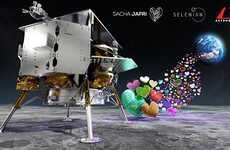
NASA's DSCOVR Spacecraft Snapped These Photos of the Moon's Transit
Rahul Kalvapalle — August 7, 2015 — Tech
NASA's Deep Space Climate Observatory (DSCOVR) spacecraft captured these rare and spectacular photos of the moon transiting across the Earth's disk. The images show the so-called dark side of the moon from a novel and fascinating angle.
The images were captured using DSCOVR's 4-megapixel Earth Polychromatic Imaging Camera. Seeing as how the opportunity to shoot the Earth and the moon together only comes around twice a year, these photos are truly impressive and rare.
The photos snapped by DSCOVR show that there is a lot more to the moon than our impression of it. Since the moon is tidally locked with the Earth, we only ever see the same side of it. However, these photos show the comparatively bare rear end of the moon, and portray the Earth as being truly bright and brilliant compared to the surface of the moon.
The images were captured using DSCOVR's 4-megapixel Earth Polychromatic Imaging Camera. Seeing as how the opportunity to shoot the Earth and the moon together only comes around twice a year, these photos are truly impressive and rare.
The photos snapped by DSCOVR show that there is a lot more to the moon than our impression of it. Since the moon is tidally locked with the Earth, we only ever see the same side of it. However, these photos show the comparatively bare rear end of the moon, and portray the Earth as being truly bright and brilliant compared to the surface of the moon.
Trend Themes
1. Moon-crossing Photography - Opportunities for photography and videography industries to capture new and unique angles of the moon.
2. Rare Celestial Events - Space exploration and observation industries can capitalize on the limited availability of celestial events like this.
3. Increasing Interest in Space - The growing public interest in space and space-related activities is driving innovation and investment in the space industry.
Industry Implications
1. Photography and Videography - Chances for photographers and videographers to create unique content and portfolios showcasing the moon from an unusual perspective.
2. Space Exploration - NASA and other space exploration companies can use this opportunity to plan future missions to study the moon in more detail.
3. Amateur Astronomy - Increased public interest in celestial events may lead to increased investment and innovation in the amateur astronomy industry.
0.9
Score
Popularity
Activity
Freshness















